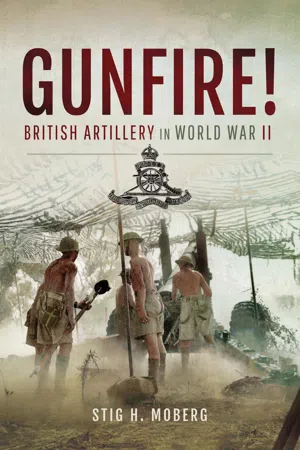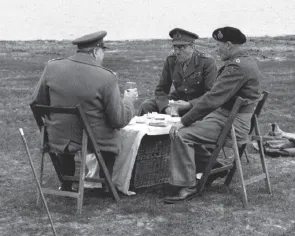![]()
Part 1
Historical Background – War and Rearmament
![]()
1. The Period Before the First World War
Two pictures
It is a battle, an intensive battle. A village can be partly seen in the background, some of its houses seem to be in flames, and in front of them we can visualise one of the combatants’ soldiers fighting their opponents in the foreground. Gunpowder smoke is dense. Between them a couple of fallen soldiers, the horse of one of them already dead, the other one in death-throes. The head and neck are stretched forwards in panic, the left leg seems to be kicking intensively, and soon life will be gone. A mounted troop in colourful uniforms is in the right corner of the picture, led by their commander with drawn sabre. Order is given: Attack!
As far as this, it could be any painting of a battle from older days. But there is an unusual element. Behind the mounted troop, there are two horizontal arcs of fire and smoke heading straight into the formation of soldiers at the opposite side. Rockets! And closer to the observer: soldiers in the same uniforms as the mounted troop is carrying can be seen. They are preparing rockets attached to wooden rods ready to fire, in a great haste, as it seems. See Fig. 1-1.
Fig. 1–1 2nd Rocket Troop Royal Horse Artillery under Swedish Command in action in the battle against Napoleon outside Leipzig, October 1813 (McCleery, O/HQ Battery [Rocket Troop] Royal Horse Artillery)
The other picture is a photograph. And it is one from the Second World War, published more often than most photographs from this war. It can be seen in hundreds, not to say thousands of books and magazine articles. On the western shore of the River Rhine the top war leaders from Britain can be seen. Churchill, Alan Brooke and Montgomery are having lunch. It is 26 March 1945. Two days earlier, the Allies had crossed River Rhine in a grand concentration of their military resources, not least artillery. Churchill and Brooke had come over from London in order to witness the crossing in company with their host Field Marshal Bernard L. Montgomery. The crossing operation commenced the night between 23 and 24 March 1945. Although numerous artillery rounds were fired after the crossing, this was the great finale on the part of the British artillery, and I will come back to this later in this book.
When looking closer at the photograph Fig. 1-2, we can see that Churchill is comfortably seated and has put his walking stick into the ground behind him; his back against the photographer. He is holding a glass in his hand. To the right of him is the host Field Marshal Montgomery, Commander of the British 21st Army Group. Opposite Churchill is the Commander Imperial General Staff, Field Marshal Alan Brooke (later Viscount Alanbrooke). Slightly bent forward, he keeps his eyes on Churchill, and we might assume that the latter is speaking just when the photograph was taken. Maybe their discussion not only dealt with the events of the last few days, but also with a question raised by Montgomery to his guests during the morning 24 March, when they witnessed the large airlanding operation taking place east of the River Rhine: ‘Now British soldiers are again fighting on German soil, when did it last take place?’ Churchill, knowing his history, told the others that it was on 18 October 1813. The British Rocket Brigade, attached to the Swedish Army, took part in the battle against Napoleon; The Swedish Army was member of the Northern Alliance of four armies under command of the Swedish Crown Prince Karl Johan (former French Marshal Bernadotte)1
Fig. 1-2 ‘Picnic’ on the western shore of the River Rhine for the three British war leaders Churchill, Brooke and Montgomery, just after Operation Plunder, the Rhine Crossing 23–24 March 1945. Churchill could tell the others of the role played by the British 2nd Rocket Troop when attached to the Swedish Army in the battle at Leipzig in October 1813 (©Imperial War Museum BU 2636)
From other sources we know that the unit was 2 Rocket Troop Royal Horse Artillery and not a complete brigade. The Troop was the only British unit taking part in the Battle of Leipzig. The fact that it actually was there may seem a bit strange, as the British Army under the Duke of Wellington fought against the French on the Iberian Peninsula. The explanation is said to be that the Duke did not like rockets:2 ‘I do not want to bring cities into flames. I cannot see any other use of rockets’. Also later in 1815 at Waterloo he demonstrated his sceptical view on the use of rocket artillery.
Rockets had been used before 1800, e.g. in India, but the one who developed the technology and organised field units in England around the period of the Napoleon wars was Sir William Congreve. He developed a set of rockets with different weights for firing at ranges of 2–3km, i.e. much longer than the range of the guns of that time. Congreve organised the rocket artillery into brigades, which in their turn comprised a number of Troops, all eager to get involved in the war against Napoleon. Upon the Duke’s dismissal, 2 Rocket Troop was sent to Northern Germany and became attached to the Swedish Army. The unit went into action after necessary adaptations and training, foremost at the Battle at Leipzig. It is said that the painting reproduced in Fig. 1-1 illustrates the Troop in action there. During the battle the Troop Commander Captain Bogue was killed and his grave is at Paunsdorf just outside Leipzig. The memory of his and the Troop’s magnificent participation in the battle is held in highest esteem in Britain.
A fact less observed is that the British rocket artillery accompanied the Swedish Army after the battle of Leipzig and took part also in the Swedish siege of the Danes at Glücksberg in December 1813 before returning to Britain in January 1814. The Crown Prince appreciated the contribution of the British gunners in the battles and awarded Lieutenant Strangways, who was nominated commander after Captain Bougue had been killed, a golden medal for gallantry in the field and also silver medals to a few other British gunners. After Strangways, Lieutenant Wright took command of the Rocket Troop and he too was awarded a gold medal before the Swedish-British cooperation ceased.3
After having heard the answer given by Churchill, Montgomery turned to his artillery chief and asked him to check as to whether any artillery formation in 21st Army Group was holding an honour title in commemoration of the battle of Leipzig and the role of the Rocket Troop in it. It was later found that the bearer of the tradition in this case was ‘O’ Battery (The Rocket Troop) Royal Horse Artillery. However, this battery was not in the vicinity at the time. It was part of a Field Regiment fighting in Italy. The discussion is a good illustration of the importance of traditions in the British Army, not least in the Royal Artillery.
The memory of the rocket gunners today is the responsibility of ‘O’/Headquarters Battery (The Rocket Troop) 1st Regiment Royal Horse Artillery. A photograph of the painting here reproduced, as Fig. 1-1 was kindly put at my disposal in 2005 by the then Battery Commander Major Jon W. McCleery. The painting is placed at the Officers’ Mess, where a dinner is organised every year in October in commemoration of the Rocket Troop and its participation in the battle at Leipzig in October 1813.4
In order to get a broader perspective on the history of British Artillery and its development as regards organisation, equipment, tactics, etc., we will take a historical journey, through the centuries up to 1939; and we start long before the nineteenth century.
The Black Prince takes to the guns
Different types of weapon had been used in battles through the centuries, among them bows and arrows and heavier equipment based on mechanical energy to throw stones and other types of projectile. These could include incendiary projectiles. Amongst battles much written about where such equipment was used is the Battle at Hastings in 1066 when William the Conqueror defeated the Anglo-Saxons under Harold Godwinson. The famous Bayeux tapestry shows how this was done.
It would take a long time until chemical energy had replaced mechanical energy as the driving force for throwing projectiles against the enemy. Exactly when gunpowder came to use is uncertain, and it is still in debate. It is, however, confirmed through literature and paintings that a kind of gun was used during the first decades of the fourteenth century. The Navy’s battle against the French Navy in 1340 is mentioned in British military literature as one of the earliest battles where guns were used. There are also paintings of guns in England dated as early as 1326.5
As to field artillery, there is a place and a year that most often references are made to in the literature and this is Crécy 1346. One can state that it was here that the British artillery emerged as a lasting force of power to determine the outcome of battles. The son of Edward III, the Black Prince, won a decisive victory over a superior French force. He managed to accomplish this thanks to a skilful use of archers and artillery. Maybe it can be stated that the paradigm shift from mechanical to chemical propellant, then gunpowder, was completed in Europe.
A permanent artillery organisation
Although guns were taken into operation during the fourteenth century, it would take a long time before artillery received a more permanent organisation in Britain. This happened first in 1486, when Henry VII created a special authority, Master of the Ordnance, appointed artillery commander and employed twelve paid gunners. They were located at the Tower of London. Later the organisation was extended with a number of Master Gunners positioned at various castles and citadels. They were to take care of the equipment when no war was taking place. Furthermore, they were also made responsible for the training of gunners and recurrent exercises. The gunners were civilians who against payment were called in to serve the guns. This artillery was organised in Traynes, an organisational form that would last for another 150 years.6 A minor exception from this structure was the establishment by Henry VIII in 1537 of the Guild of St. George, which oversaw what later became Honourable Artillery Company (HAC), the duty of which was ‘to be overseers of the science of artillery […] for the better increase of the defence of our realm’.7 At its establishment, it was given the magnificent name Fraternity of Guild of Artillery of Longbows, Crossbows and Handguns; hence it did not have much in common with ‘artillery’ of later years.8 Artillery pieces were not provided until the late eighteenth century. The HAC has always had a close relation to the city of London and from time to time reinforced the local police. When the Territorial Army was established (see below) the HAC was attached to the artillery as well as infantry units. Four Field Regiments were mobilised by HAC in the Second World War. Amongst ceremonial duties it fires salutes from the Tower of London, a responsibility given in 1924. The HAC is considered to be amongst the oldest regiments of the British Army.
We are returning now to the sixteenth century and the establishment of the British Empire, which had commenced with Queen Elizabeth I as one of the key persons behind it. The interest on the part of the Queen was aimed primarily to establish trade links and to take advantage of colonisation.9 Of particular interest was India, which brought about the establishment in 1600 of the East India Company, a company that later gra...


